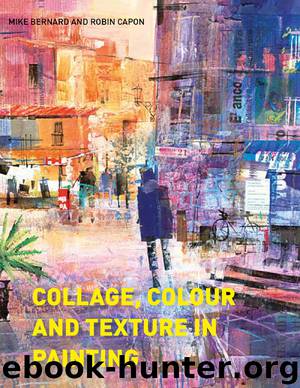Collage, Colour and Texture in Painting by Mike Bernard

Author:Mike Bernard
Language: eng
Format: epub
ISBN: 9781849943857
Publisher: Pavilion Books
Published: 2016-02-05T16:00:00+00:00
Collage in action
The way that I normally develop a painting, starting with the initial foundation work in collage, is demonstrated in the five step-by-step illustrations for Polperro Harbour.
In Stage 1, you can see how I have built a collage from pieces of paper to establish a sense of the basic design for the painting. There is a dark shape on the left, which is the first indication of the foreground sea wall; similarly, an orange/brown rectangular piece of paper, centre right, creates a foundation texture for another section of the harbour wall. Additionally, the newspaper at the top hints at some fishermen’s cottages, while some wrinkled tissue paper below suggests where the water is going to be.
This might imply that I am only thinking about the subject matter in literal terms. However, I am also considering the way that various shapes interrelate and begin to create interest and balance within the design. For instance, you will see that I have placed some tissue-paper shapes at the top to balance the ones in the foreground. Equally, I am thinking of the textures and how these could be used to advantage later on.
Next, as in Stage 2, I sometimes develop the collage further, before starting to apply the two main colours that I have chosen for the subject. I decided to use a blue and a golden sand colour for this painting, working as usual with acrylic inks and applying them with a soft-haired 5 cm (2 in) varnishing brush. The collage must be dry before starting on this stage, for which I first wet the paper by spraying it with water. With the painting held vertically at an easel, I apply the colours quite randomly, allowing them to run and create haphazard effects.
With the entire painting surface now covered in some way, either with collage or colour, I begin to think more particularly about textures. For those areas in which a rich textural quality will be useful, I use white acrylic paint, which is applied quite freely with a lino-printing roller, as shown in Stage 3. Again, I aim to create a sense of unity in the painting by repeating the texture in different areas, although avoiding those passages of the initial blue or golden sand colour which I estimate will relate to specific parts of the subject matter. As well as adding texture, the white acrylic paint imparts a luminosity to the painting later on, when coloured glazes made from diluted acrylic inks are applied over it.
During the next stage, with a fresh look at the location drawing, and where appropriate exploiting the divisions, marks and surface effects that are now part of the painting, I start to resolve the essential elements. As you can see in Stage 4,
I have now defined the main house, using white acrylic paint, and with black acrylic ink offset from the edge of a piece of card, I am putting in some fencing posts. The challenge is to balance areas that give meaning and definition with those that are left as textural, abstract qualities.
Download
This site does not store any files on its server. We only index and link to content provided by other sites. Please contact the content providers to delete copyright contents if any and email us, we'll remove relevant links or contents immediately.
| Body Art & Tattoo | Calligraphy |
| Ceramics | Conceptual |
| Digital | Erotic |
| Film & Video | Glass |
| Graffiti & Street Art | Illuminations |
| Installations | Mixed Media |
| Mosaic | Prints |
| Public Art | Video Games |
Kathy Andrews Collection by Kathy Andrews(11730)
Thirteen Reasons Why by Jay Asher(8796)
The Red Files by Lee Winter(3368)
How to Do Nothing by Jenny Odell(3232)
The Genius of Japanese Carpentry by Azby Brown(3224)
Stacked Decks by The Rotenberg Collection(2812)
Tattoo Art by Doralba Picerno(2600)
Champions of Illusion by Susana Martinez-Conde & Stephen Macknik(2414)
The Artist's Way Workbook by Cameron Julia(2196)
The Art of Doom by Bethesda(2108)
Calligraphy For Dummies by Jim Bennett(1992)
Creative Character Design by Bryan Tillman(1888)
Botanical Line Drawing by Peggy Dean(1812)
Wall and Piece by Banksy(1781)
The Art of Creative Watercolor by Danielle Donaldson(1777)
One Drawing A Day by Veronica Lawlor(1767)
Art Of Atari by Tim Lapetino(1750)
Pillars of Eternity Guidebook by Obsidian Entertainment(1625)
Happy Hand Lettering by Jen Wagner(1558)
